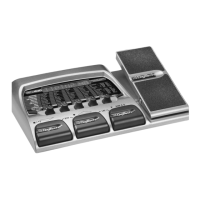ping the input of other effects. It sets a maximum boundary (Threshold) for the strength of a signal. If a
signal exceeds the Threshold, it is adjusted based upon the compression ratio setting.
Comp On/Off - The Number 1 Knob turns the Compressor on (
On) and off (OF).
Attack - The Number 2 Knob adjusts the length of time it takes for the Compressor to respond to a sig-
nal exceeding the Threshold. Values include:
fast, medium, and slow.
Ratio - The Number 3 Knob adjusts the input to output ratio once the Threshold has been exceeded.
For instance, a Ratio of 4 to1 means that a signal exceeding the Threshold by 4 dB will only be
allowed 1 dB of increased output. Ranges include: 1.2-1 (1.2 to 1), 1.5-1 (1.5 to 1), 1.8-1 (1.8 to
1), 2.0-1 (2 to 1), 2.5-1 (2.5 to 1), 3.0-1 (3 to 1), 4.0-1 (4 to1), 5.0-1 (5 to 1), 8.0-1 (8 to 1), 10-1
(10 to 1), 20-1 (20 to 1), and 00-1 (infinity to 1).
Threshold - The Number 4 Knob adjusts the maximum strength the signal is allowed to reach before the
compressor begins to work. Ranges from 1 to 99.
Gain - The Number 5 Knob adjusts the Output Gain from the Compressor. Ranges from 0 to 6 (dB).
Amp Modeling/Cabinet
Amp Modeling is a technology that applies a vintage or modern amp tone to your guitar signal. The
RPx400’s Amp Modeling also provides an acoustic guitar simulation. The Amp Modeling section includes
an A and a B channel. Each channel can be individually programmed to include different settings for Amp
Gain,Amp Level, Cabinet Type, Mic Position, and EQ. This allows you to switch from a clean to a distort-
ed setting while retaining all other Effects settings. Switching Amp channels is accomplished instantly with
the Amp A/B Footswitch.
The Cabinet Modeling simulates different types of miked speaker cabinets. You have your choice of 6
Cabinet Types and 4 Mic Placements in relationship to each speaker cabinet.
Amp Channel - The Number 1 Knob selects the A or B channel. You may also use the A/B Footswitch to
select the amp channel during the editing process.
Amp Type - The Number 2 Knob selects one of the Amp Models or Acoustic Simulator. Choices
include:
Marshall® is a registered trademark of Marshall Amplification Plc. Vox® is a registered trademark of Korg UK. Fender, Matchless, and Mesa Boogie, are
trademarks of their respective companies and are in no way associated with DigiTech.
Amp Gain - The Number 3 Knob adjusts the Gain (distortion) for the selected Amp Model (not available
for Acoustic). The Gain parameter ranges from 0 to 99.
Amp Level - The Number 4 Knob adjusts the Level (volume) of the selected Amp Model. The Level
parameter ranges from 1 to 99.
Cabinet-Mic - The Number 5 Knob selects the type of cabinet model as well as mic placement in rela-
tion to the speaker. Your choices include:
DIRECT - Turns the modeling off
BLKFAC - Based on a ‘65 Fender Twin Reverb
BOUTIQ - Based on a Matchless DC30
RECTIF - Based on a Mesa Dual Rectifier
HOTROD - Based on a Mesa Boogie Mark II C
tweeD - Based on a ‘57 Fender Tweed Deluxe
CLEAN1 - Based on a Vox AC30 top boost
CLEAN2 - A clean tube combo setting
STACK - Based on a Marshall JCM900
CRUNCH - A nice crunchy combo
HIGAIN - Based on a Johnson JM150 High Gain
FUZZ - A vintage fuzz distortion
ACOUST - A flat top acoustic guitar
13
Creating Presets

